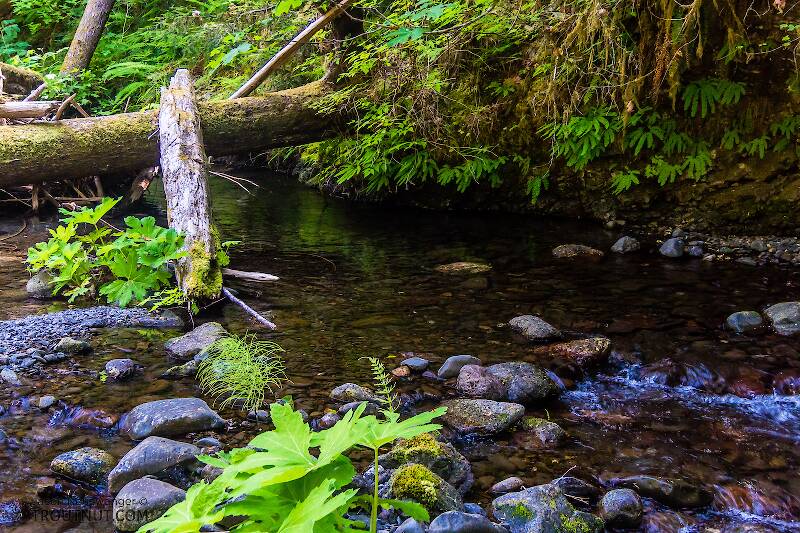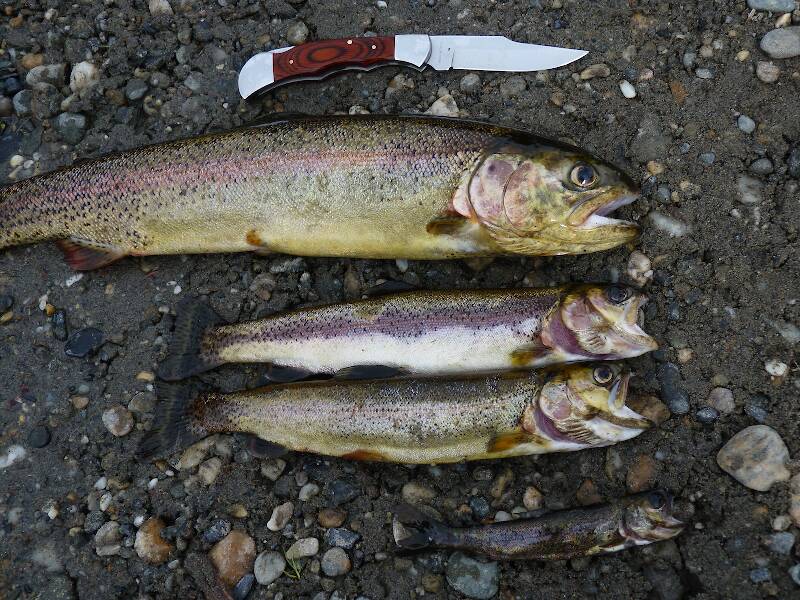
Salmonflies
Pteronarcys californica
The giant Salmonflies of the Western mountains are legendary for their proclivity to elicit consistent dry-fly action and ferocious strikes.
Featured on the forum

This one seems to lead to Couplet 35 of the Key to Genera of Perlodidae Nymphs and the genus Isoperla, but I'm skeptical that's correct based on the general look. I need to get it under the microscope to review several choices in the key, and it'll probably end up a different Perlodidae.

Troutnut is a project started in 2003 by salmonid ecologist Jason "Troutnut" Neuswanger to help anglers and
fly tyers unabashedly embrace the entomological side of the sport. Learn more about Troutnut or
support the project for an enhanced experience here.
GldstrmSam on Sep 21, 2012September 21st, 2012, 11:38 am EDT
Hi Fellow Fly Fishers,
This is probably a question for Jason, but if anybody else can answer that would be great also.
I know that in the spring-early summer the grayling start working there way up stream to spawn. I also know that some then migrate back down to winter in the larger rivers like the Tanana.
What I was wondering is what percent of grayling if any remain in the upper part of a stream over the winter.
The reason I was asking is that today I went fishing in the upper part of a grayling stream and I did not see or feel any action. I don't know if the higher water and low visibility led to that, or if the fish migrated back downstream already.
This is probably a question for Jason, but if anybody else can answer that would be great also.
I know that in the spring-early summer the grayling start working there way up stream to spawn. I also know that some then migrate back down to winter in the larger rivers like the Tanana.
What I was wondering is what percent of grayling if any remain in the upper part of a stream over the winter.
The reason I was asking is that today I went fishing in the upper part of a grayling stream and I did not see or feel any action. I don't know if the higher water and low visibility led to that, or if the fish migrated back downstream already.
There is no greater fan of fly fishing than the worm. ~Patrick F. McManus
GONZO on Sep 21, 2012September 21st, 2012, 12:37 pm EDT
Sam,
Although I'm sure Jason can provide more insight into your area of the state, here is a summary from USF&WS/ANWR:
Based on that, it would seem that your grayling might have moved to overwintering areas. However, here is a personal anecdote about a similar high water/low visibility situation that may (or may not) have some bearing:
In late September and early October of 2005, a friend and I were fishing the "Three Rivers" area north of Anchorage (as well as the Kenai to the south). At the beginning of that time, we had fast and easy fishing for a mix of grayling, dollies, and rainbows in the mainstem of the Talkeetna near some of its tributaries. When we moved up one of the tribs (Clear Creek), we found good numbers of dollies and rainbows associated with the last of the spawning silvers, but no grayling. Later on, after some fabulous rainbow and dolly fishing on the Kenai, we returned to fish the Talkeetna again. There had been some significant snow and rain that had raised the level quite a bit and discolored the water. The same stretch that had produced so well about a week before seemed to be virtually fishless.
Best,
Lloyd
Although I'm sure Jason can provide more insight into your area of the state, here is a summary from USF&WS/ANWR:
Arctic grayling have adapted to the rigors of the climatic and physical environment of the arctic. For almost nine months of the year, grayling are confined to relatively small reaches of stream and river channels for overwintering. The available overwintering habitat is critical to their survival and is considered to be the major limiting factor for populations of arctic fishes. After break-up, which begins in late May or early June, Arctic grayling expand their distribution to include streams and rivers that were previously frozen. Glacial rivers are used as migration corridors to tundra streams where grayling spawn and rear. The fish appear to return and spawn in the same stream in which they were born. Young of the year fish emerge from the gravel in late June and early July. In August and September, Arctic grayling return to overwintering areas in river channels associated with year round springs and deep pools. Grayling mature between the age of six and nine years.
Based on that, it would seem that your grayling might have moved to overwintering areas. However, here is a personal anecdote about a similar high water/low visibility situation that may (or may not) have some bearing:
In late September and early October of 2005, a friend and I were fishing the "Three Rivers" area north of Anchorage (as well as the Kenai to the south). At the beginning of that time, we had fast and easy fishing for a mix of grayling, dollies, and rainbows in the mainstem of the Talkeetna near some of its tributaries. When we moved up one of the tribs (Clear Creek), we found good numbers of dollies and rainbows associated with the last of the spawning silvers, but no grayling. Later on, after some fabulous rainbow and dolly fishing on the Kenai, we returned to fish the Talkeetna again. There had been some significant snow and rain that had raised the level quite a bit and discolored the water. The same stretch that had produced so well about a week before seemed to be virtually fishless.
Best,
Lloyd
Troutnut on Sep 21, 2012September 21st, 2012, 5:16 pm EDT
Hi Sam,
I don't know if anyone's documented exactly what percentage of grayling remain in clear streams during the winter, and how many move all the way down to the big glacial rivers. It would be really hard to quantify that since you can't sample them effectively under 3 feet of ice. I would guess that many, if not most, overwinter in rivers like the Chena, but in a small number of ideal locations.
During my fieldwork on the Chena I spent plenty of time grayling fishing while my cameras were rolling on the juvenile salmon, all the way through into October. I was seeing grayling in the river throughout this period, all the way to ice-up, but the fishing really slowed down in late September and October. I think that's caused by both fish moving out of the system and fish feeding less aggressively as the water cools down.
I don't know if anyone's documented exactly what percentage of grayling remain in clear streams during the winter, and how many move all the way down to the big glacial rivers. It would be really hard to quantify that since you can't sample them effectively under 3 feet of ice. I would guess that many, if not most, overwinter in rivers like the Chena, but in a small number of ideal locations.
During my fieldwork on the Chena I spent plenty of time grayling fishing while my cameras were rolling on the juvenile salmon, all the way through into October. I was seeing grayling in the river throughout this period, all the way to ice-up, but the fishing really slowed down in late September and October. I think that's caused by both fish moving out of the system and fish feeding less aggressively as the water cools down.
Jason Neuswanger, Ph.D.
Troutnut and salmonid ecologist
Troutnut and salmonid ecologist
GldstrmSam on Sep 21, 2012September 21st, 2012, 11:57 pm EDT
Thank You Lloyd and Jason. That answered my question.
I know a couple people who have fished this creek in the same place that I did and have very good success, but unfortunately none of them remember what time of year they fished it.
The stream is about 1-3 feet deep with some pools that might be closer to 4' or 5'. So I'm figuring that most if not all were gone with the remaining ones not striking because of higher water and low visibility.
Thanks again,
Sam
I know a couple people who have fished this creek in the same place that I did and have very good success, but unfortunately none of them remember what time of year they fished it.
The stream is about 1-3 feet deep with some pools that might be closer to 4' or 5'. So I'm figuring that most if not all were gone with the remaining ones not striking because of higher water and low visibility.
Thanks again,
Sam
There is no greater fan of fly fishing than the worm. ~Patrick F. McManus
Troutnut on Sep 22, 2012September 22nd, 2012, 12:57 am EDT
Mind telling me which creek? (In a private message if you don't want the public to see.) Maybe I know something about it specifically.
Jason Neuswanger, Ph.D.
Troutnut and salmonid ecologist
Troutnut and salmonid ecologist
Quick Reply
Related Discussions
Topic
Replies
Last Reply
Re: 15 Pound Steelhead (Trout) caught in Bosnia (Slideshow & Videos included)
In Fishing Reports by IvansFishin
In Fishing Reports by IvansFishin
4
Jan 27, 2017
by IvansFishin
by IvansFishin
1
Jan 1, 2016
by Martinlf
by Martinlf
3
Nov 19, 2006
by GONZO
by GONZO
18
Jun 24, 2016
by Oldredbarn
by Oldredbarn



